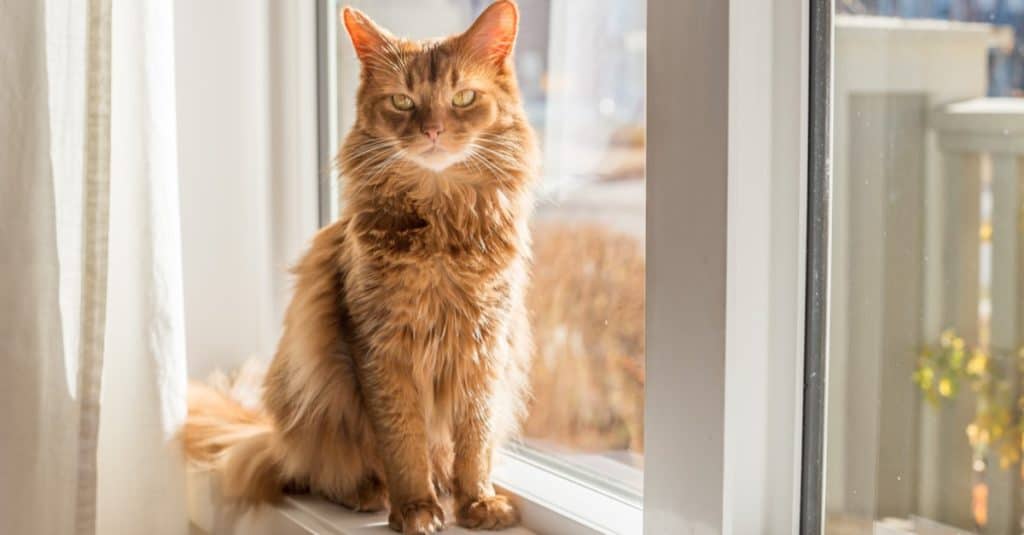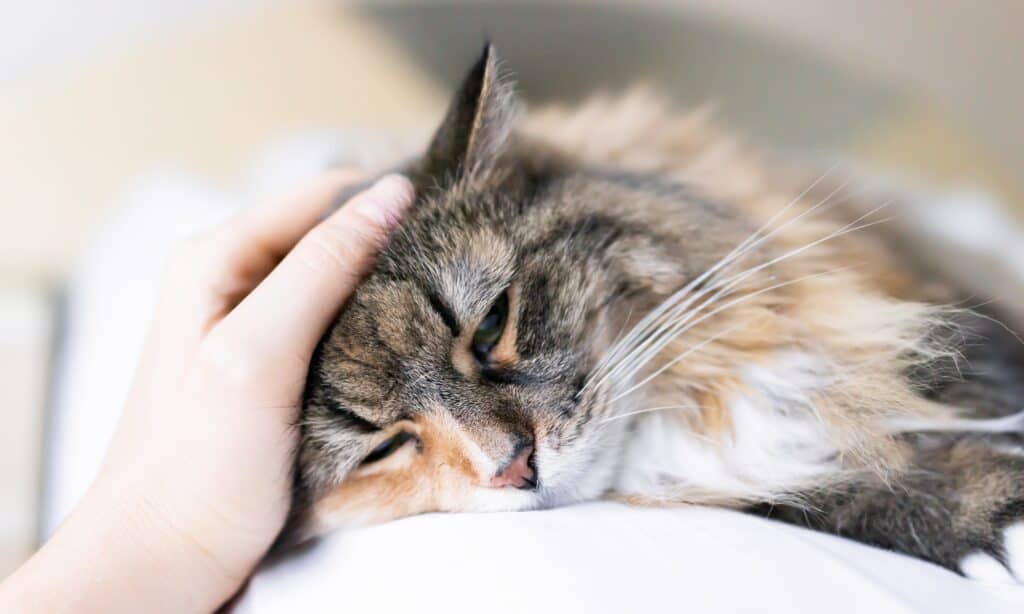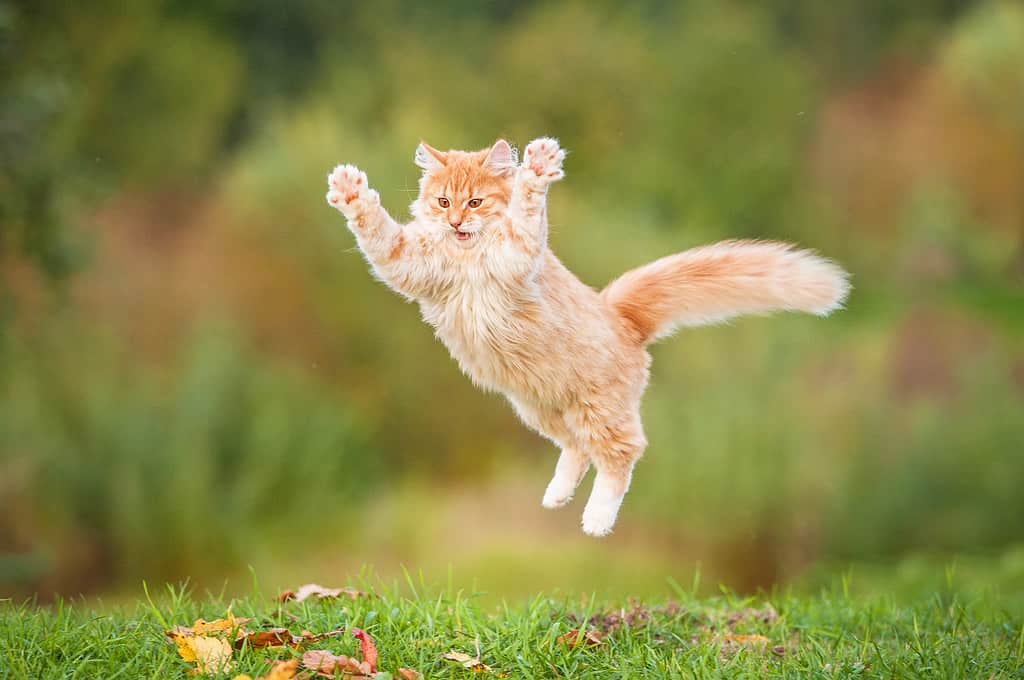Have you ever seen a cat fall from a great height only to land gracefully on its feet? It’s almost like the cats possess superhuman balancing abilities — in some ways, they do! Scientists have been studying cats’ evolutionary traits for years, trying to understand why cats can always seem to land on their feet.
If you’re as intrigued by this phenomenon as we are, keep reading to learn more about the science behind cats’ balancing skills. We’ll dive into how these remarkable creatures stay upright even after a significant fall.
How Cats Always Land on Their Feet

Cats land on their feet thanks to certain physical attributes.
©Nils Jacobi/Shutterstock.com
Various scientifically proven factors enable cats to land on their feet gracefully every time they fall. Cats have an innate ability that allows them to orient themselves while in the air to find a proper landing. Some physical attributes that allow cats to land on their legs include:
Righting Reflex
Cats have an innate ability called the righting reflex, which allows them to shift their position in mid-air to land safely using their feet. The righting reflex ability is a skill that kittens learn from as young as 3-4 weeks old and can successfully perform it by the time they are 6-7 weeks old. Well, how does their righting reflex work? Cats can turn themselves into the proper position during a fall because of the following distinct features:
The Vestibular Apparatus in the Cat’s Inner Ear
The vestibular apparatus inside the ear gives the cat its orientation and balance during a fall. The cat uses its inner ear to understand its body equilibrium and position to achieve balance.
The vestibule contains tiny stones (otoliths) and fine hairs attached to the cat’s nerves. When a cat turns its head, the little stones in the vestibule bend the fine hairs, signaling to the brain which direction the cat’s head is facing. The semi-circular canals in the cat’s inner ear are filled with fluid, which helps the brain detect movements and rotation.
Therefore, you will notice that your cat will rotate its head mid-air to identify which way is up and then turn the rest of its body to land on its feet.
Skeletal Features
Since cats do not have a collarbone, their backbone, which contains 30 vertebrae, is very flexible. Having a flexible spine allows your cat to shift its position fast and efficiently while still in the air so it can land on its feet.
Flexibility
Another reason why cats land on their feet is their unmatchable flexibility. Have you ever seen a cat flip its body in the air? It is a sight to behold. When landing, the cat arches its back to bring its feet underneath the rest of its body. Also, the cat places its forepaws near the head for protection when it lands. This ability to move different body parts swiftly during a fall is one of the reasons why cats always land on their feet.
Low Body-to-Weight Ratio
Healthy cats have a low body-to-weight ratio that reduces their velocity during the fall, allowing them to land more quickly on their feet. The average weight of a domestic cat is 4.5 kilograms or 10 pounds. However, other factors may affect the ideal weight of your cat. They include:
- Sex
- Age
- Breed
- Neuter/spay status
For example, a Maine Coon cat can weigh 25 pounds and be considered very healthy, while a Persian cat can weigh only 8 pounds and be healthy.
Body weight ratio is a significant factor in determining whether a cat will land safely on its feet because the mortality rate of obese cats aged between 8 and 12 years is three times higher than that of lean cats.
If your cat is obese, it might not be flexible enough to turn mid-air to adjust its position and land safely on its feet. Does your cat weigh 10 or 20% more than its ideal weight? If this is the case, we recommend introducing more activities into your cat’s day to help it lose weight.
Instinctual Behavior
The ability of cats to land on their feet is instinctual behavior, which they do not need to be taught. If you were given a kitten as a gift and raised it in your apartment, where it had no access to other cats, then you might have caught it landing on its feet several times.
How on earth did they learn to do that? The cat used their instincts. A cat’s righting reflex is its instinctual response when falling from a high place.
Sturdy Legs
The legs of a cat can significantly impact how it lands on the ground. Although the legs of a cat appear slender and long, they are muscular and strong enough to reduce impact and absorb the shock when landing.
Moreover, cats have angled legs to minimize the impact so that the landing force does not affect their stability when they reach the ground. However, overweight cats may fail to land on their feet because they lack flexibility.
Does the Distance of the Fall Affect the Cat’s Landing?
Yes. The distance of the fall has a massive influence on how cats always land on their feet, which is shocking. Scientists think the longer the cat falls, the more time it has to adjust its body to land safely on its feet.
The Animal Medical Center in New York conducted a study on cats in 1987, analyzing the vet records of several cats that had jumped from multi-story buildings. The statistics revealed that although most cats landed on concrete, 90% survived, and only 37% needed emergency care.
The cats that fell from buildings with 7 to 32 stories suffered fewer injuries than those that fell from buildings with 2 to 6 story levels. A cat that fell from a 32-story building was released from emergency care after 48 hours, despite landing on concrete. The cat only sustained a minor lung puncture and a chipped tooth.
How Often do Cats Land on Their Feet?

Cats have an uncanny ability to land on their feet, though not always.
©Miroslav Halama/Shutterstock.com
Most of the time, cats always land on their feet. However, there may be instances where a cat may fail to land on its feet, especially if the height is too short and the cat does not have enough time to orient itself. For example, if you accidentally push your sleeping cat off the couch with your feet, it may land on its side instead of its feet.
Although righting reflex may take less than a second, cats need at least two and a half feet to land correctly on their feet. However, cats may still sustain injuries even with the proper distance after falling.
What Is High-Rise Syndrome?

A cat may be injured after falling from a steep height, known as high-rise syndrome.
©R. Hutch Photography/Shutterstock.com
High-rise syndrome is a term that describes the injuries cats sustain after falling from steep heights. For example, if your cat falls down the fire escape, a story building, a balcony, window, or any other raised area and sustains injuries, they develop high-rise syndrome. Cats tend to develop high-rise syndrome during warm months because most windows are usually open.
Cats enjoy sitting in high places like windows and balconies to bask in the sun or watch the birds. If a bird lands too close to the cat, it may lunge after the bird, thereby involuntarily jumping off the edge of the raised place and falling.
Sometimes cats fall asleep on tree branches, then slip and fall. Some curious cats may find themselves on the edge of a rooftop, where they accidentally slip and fall.
The above examples show cats do not always fling themselves from steep heights. Sometimes cats fall by accident. However, despite the type of fall, cats always land on their feet. Cats prefer high places because they can look for danger and spot their prey more easily.
If your cat falls from a high height, we recommend taking them to the vet for careful inspection of injuries. Some of the signs and symptoms of high-rise syndrome include:
- Missing teeth
- Broken jaw
- Head bruises
- Broken limbs
- Spinal fractures
- Damage to internal organs
- Soft tissue tears
- Punctured lungs
- Ruptured bladder
- Death
The type of treatment a cat with high-rise syndrome receives depends on the severity of its injuries.
What To Do if Your Cat Is Injured After a Fall

After your cat, they should visit the vet to rule out internal injury.
©iStock.com/LENblR
Although your cat may not show any physical signs of trauma, ensure that you take them to veterinary care because they may have sustained internal injuries. We recommend monitoring your cat for 12 to 48 hours immediately after the fall to see whether they exhibit any symptoms.
Look out for the following alarming symptoms in your cat after a fall:
- Difficulty drinking or eating
- Abnormal stool
- Lethargy
- Limping
- Discomfort when you pet them
- Inability to stand
- Unwillingness to walk
- Panting
- Bleeding
- Bruising
- Difficulty bleeding
- Unable to urinate
When you identify the above symptoms in your cat, immediately take them to the nearest veterinary ER. Here, they will assess their condition, and in urgent cases, the vet may administer oxygen therapy, pain medication, or IV fluids. We also advise requesting blood work and x-rays to determine whether your pet sustained internal injuries after falling.
First Aid Tips for High-Rise Syndrome

Look carefully for any signs of distress or injury after your cat falls.
©iStock.com/krblokhin
Even though cats always land on their feet, they are not invincible and may sustain serious injuries. Here are some first-aid tips that might save your cat’s life.
Monitor Their Breathing
If you realize that your cat struggles to breathe after a fall, we recommend rushing them to the nearest veterinary clinic. If your cat is panting, it signals respiratory distress because cats can’t breathe through their mouths like dogs. Ensure you handle your cat carefully when taking it to the vet because it may also have broken ribs or a punctured lung.
Place your cat in a pet carrier for easy transportation. If you don’t have access to a pet carrier, you can use a baking sheet, which will act as a gurney as you carry your cat. Observe what your cat prefers. Let them sit up if they would rather do that than lie down.
If your cat stops breathing, we recommend ventilating them to prevent suffocation. Wrap your hand around their muzzle to create a funnel and blow air through your hand into their nose. Ensure that their mouth is closed. If you do it right, you will notice their chest volume increase.
Cover the Wounds
If your cat has open wounds after the fall, ensure that you cover the injuries with a clean towel to avoid contamination. You may observe some bone protruding in the wound. Do not leave the bone exposed because bone infections are complicated to heal. Cover the bone with a clean towel and take your cat to the vet.
Check for Head Injuries
Common signs of a head injury include blood in the mouth, eyes, and nose. Usually, cats will swallow any blood in their mouth and lick the blood that flows from their nose. Head injuries may indicate trauma to the brain, so ensure that your cat receives a checkup soonest possible.
Control the Bleeding
If your cat is bleeding after a fall, wrap a towel around the wound and gently apply firm pressure. When blood soaks the towel, don’t replace it. Place another towel on top of it and keep applying pressure. After around 5 or 10 minutes, the bleeding will stop. Once you control the bleeding, take your cat to the vet for more inspection.
How To Protect Your Cat From Falling

Use a window screen to cat-proof your home and ensure your cat doesn’t fall from a high height.
©iStock.com/golfbress
If your apartment or a house has two or more stories, we recommend taking precautions to prevent your cat from developing high-rise syndrome. Some great tips to keep your cat from falling from high places include:
Cat-Proof Your Home
Ensure that your cat remains indoors at all times to prevent them from climbing buildings, roofs, or trees. A great way to approach this would be to permanently close your doors and install secure screens on your windows. Your cat will most likely remain inside the house when you are at work or school.
If you have a balcony, make sure that you enclose it so that your cat does not fall when playing on the patio. You can even use chicken wire or mesh screens to enclose your balcony and keep your cat safe.
Trim the Cat’s Claws
If your cat loves the outdoors, keeping it indoors may not be effective for long. We suggest that you avoid trimming the claws when grooming your cat. The long claws will give your outdoor cat more traction if they slip on steep terrain.
Understand Why Your Cat Lands Using Its Feet

Cats are naturally curious and playful, which helps them land on their feet.
©Rita_Kochmarjova/Shutterstock.com
Cats always land on their feet because they are naturally curious climbers. Their righting reflex, sturdy legs, instinctual behavior, flexibility, and low body-to-weight ratio ensure that cats survive most falls from steep heights.
Moreover, cats are more likely to survive a fall and land correctly on their feet if the distance is long, compared to short distances. Long falls give cats enough time to rotate their head, adjust their body, position their feet, and land steadily on their legs. When the distance is too short, the cat may hit the ground before the righting reflex occurs. If your cat suffers a fall, make sure that you seek veterinary care immediately to treat any injuries.
The photo featured at the top of this post is © Miroslav Halama/Shutterstock.com
Thank you for reading! Have some feedback for us? Contact the AZ Animals editorial team.






